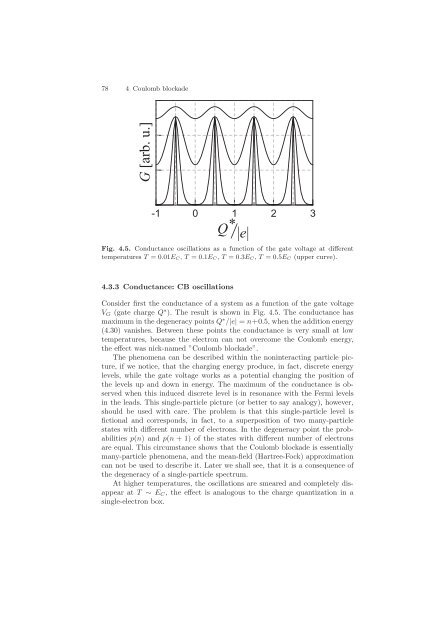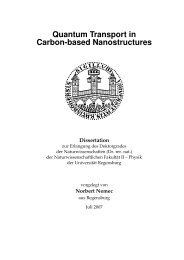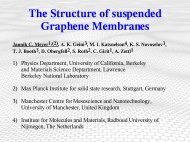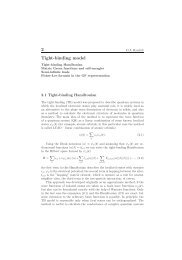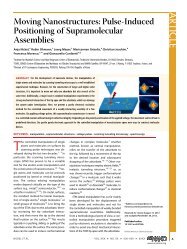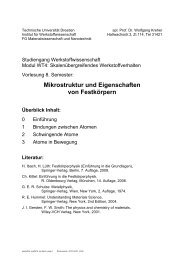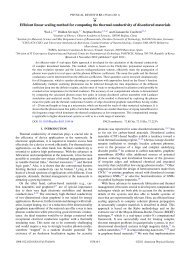4 Coulomb blockade
4 Coulomb blockade
4 Coulomb blockade
You also want an ePaper? Increase the reach of your titles
YUMPU automatically turns print PDFs into web optimized ePapers that Google loves.
78 4 <strong>Coulomb</strong> <strong>blockade</strong><br />
G [arb. u.]<br />
-1 0 1 2 3<br />
Q /|e|<br />
*<br />
Fig. 4.5. Conductance oscillations as a function of the gate voltage at different<br />
temperatures T =0.01EC, T =0.1EC, T =0.3EC, T =0.5EC (upper curve).<br />
4.3.3 Conductance: CB oscillations<br />
Consider first the conductance of a system as a function of the gate voltage<br />
VG (gate charge Q ∗ ). The result is shown in Fig. 4.5. The conductance has<br />
maximum in the degeneracy points Q ∗ /|e| = n+0.5, when the addition energy<br />
(4.30) vanishes. Between these points the conductance is very small at low<br />
temperatures, because the electron can not overcome the <strong>Coulomb</strong> energy,<br />
the effect was nick-named ”<strong>Coulomb</strong> <strong>blockade</strong>”.<br />
The phenomena can be described within the noninteracting particle picture,<br />
if we notice, that the charging energy produce, in fact, discrete energy<br />
levels, while the gate voltage works as a potential changing the position of<br />
the levels up and down in energy. The maximum of the conductance is observed<br />
when this induced discrete level is in resonance with the Fermi levels<br />
in the leads. This single-particle picture (or better to say analogy), however,<br />
should be used with care. The problem is that this single-particle level is<br />
fictional and corresponds, in fact, to a superposition of two many-particle<br />
states with different number of electrons. In the degeneracy point the probabilities<br />
p(n) andp(n + 1) of the states with different number of electrons<br />
are equal. This circumstance shows that the <strong>Coulomb</strong> <strong>blockade</strong> is essentially<br />
many-particle phenomena, and the mean-field (Hartree-Fock) approximation<br />
can not be used to describe it. Later we shall see, that it is a consequence of<br />
the degeneracy of a single-particle spectrum.<br />
At higher temperatures, the oscillations are smeared and completely disappear<br />
at T ∼ EC, the effect is analogous to the charge quantization in a<br />
single-electron box.


